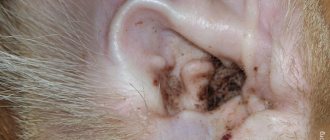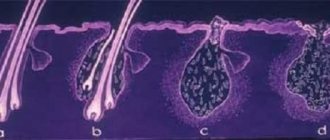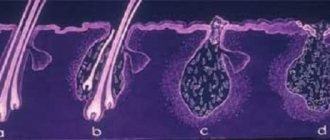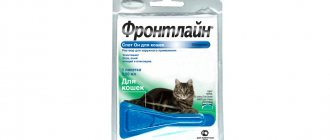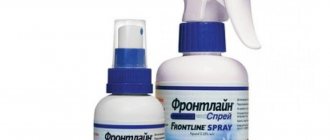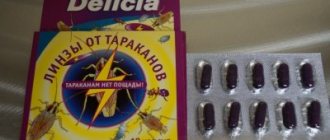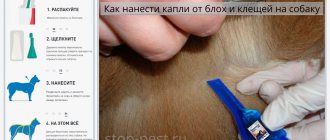Summer is in full swing, which makes the owners and their four-legged companions happy: swimming in ponds, wallowing in the grass, long walks... But you know that there is a factor that can darken all the warm days for your pet. These insects are parasites that love to live in animal fur. We are talking about fleas, ticks, mosquitoes. They suffer many unpleasant illnesses, which makes them doubly dangerous. Should I use Frontline products for dogs when fighting insects? We’ll talk about this in detail in this article, asking experts and just owners of shaggy friends.
Description and composition
Frontline is a whole series of drugs for cats, dogs and ferrets from the international brand Merial (located in Lyon, branded by Boehringer Ingelheim). The company also produces vaccines and anti-worm medications, cosmetics and much more.
Repellents for Frontline are available in several forms:
- Spot-on (disposable pipettes);
- Pills;
- Spray;
- Combined drugs against several types of parasites.
The active ingredients in the products are different. These can be fipronil and S-methoprene, afoxolaner, permethrin. All of them are safe and do not cause allergies in animals.
How to distinguish from a fake
Expensive, foreign medicines are profitable to counterfeit, so let’s find out how to find the original product:
- this drug is available in a single dosage; always on sale in paper containers;
- The batch number is always indicated (it is also marked on the plastic pipette) and until what date it can be used;
- the boxes should contain a booklet with instructions for providing first aid to a four-legged animal;
- to protect small children, the tube of medicine is always placed in a plastic shell;
- it is recorded on the bottles (manufacturer’s name, % of active substance, how many ml, name and type, indication that the product is intended strictly for manipulation with animals);
- Photos of animals and color schemes may differ on cardboard boxes;
- “Russian Standard” is a sign for drugs packaged in the Russian Federation.
How do drugs work?
Attention! Before use, consult a specialist.
You need to choose a product based on your pet’s problems and taking into account what parasites live in your region.
Frontline Act Three
It acts on 18 species of flying insects, and not only repels them, but also has an insecticidal effect. Thus, the product prevents many diseases, including piroplasmosis, Lyme disease, leishmaniasis, etc.
Frontline NexgarD tablets
Used to combat ticks and fleas. It works faster than drops and is suitable for both adult dogs and puppies. The effect of the tablet lasts about a month.
Frontline spot-on
Suitable for those animals that cannot walk in a collar or do not recognize the spray. Can be used every month. Fights otodectosis in animals.
Frontline combo
Can be used not only for dogs, but also for cats and ferrets. It destroys ticks in two days, fleas in a day. It is water resistant.
Frontline spray
It works quickly (as soon as it dries on the fur), but is not very suitable for large animals. Does not cause local allergic reactions.
Drug safety studies
The instructions indicate that, according to GOST 12.1.007-76, medicines from the Spot On, Tri-Act, Combo and Spray lines belong to the 3rd hazard class (moderately hazardous substances), and NexgarD and Spectra - to the 4th class ( low-hazard substances). These results are confirmed by research from the manufacturer.
For the experiment, 4 primary groups were formed. The first was not treated with medication, the second received the drug in a single dosage, the third in a three-fold dosage, and the fourth in a five-fold dosage. The condition of the animals was monitored using clinical tests, skin biopsy, and histological studies.
The results of the analyzes showed that there were no differences in the well-being and condition of the pets of different control groups.
Additionally, a similar analysis was carried out on puppies. It was found that in some kittens, the antiparasitic agent leads to increased discharge from the eyes and the formation of dandruff. But in general, children tolerate the medication well.
Today, the results of pharmacological research continue. Over the entire period of the program, Frontline has treated over 3 million animals of different ages, sizes and breeds. Only isolated cases of treatment regarding side effects were recorded. However, all of them were not directly related to the use of the drug - it could only influence the occurrence of negative reactions indirectly.
However, a number of breeders claim that the medication has a mutagenic effect. In particular, there have been cases of puppies being born with conjunctivitis and dermoids of the eyelids from parents who previously gave birth to healthy litters. These data have not been clinically confirmed, but they should be taken into account by nursery owners.
Mechanism of action of drugs
The drugs contain different substances, their mechanism of action is different. But the main thing is that in complex preparations the active substances do not neutralize each other’s work.
- Fipronil, entering the insect's body through the skin, blocks the transmission of nerve impulses, and this disrupts the functioning of the nervous system and leads to paralysis. Insects die in about 8 hours.
- S-methoprene does not allow chitin to develop correctly, therefore it stops the development of fleas that are in the egg, pupa or larvae stage. Penetrates the shell of eggs that have been recently laid.
- Afloxaner is a GABA-dependent receptor blocker, disrupts the transmission of nerve impulses and provokes the development of paralysis in insects.
- Permethrin inhibits the polarization of nerve cells in insects, which also leads to paralysis.
Preparing the premises
The treatment procedure with any insecticidal agent is carried out provided that the object is prepared for this. And if you are using a drug that is characterized by moderate effectiveness, it is important to carry out this procedure as carefully as possible, because in this case you cannot count on a prolonged effect. In addition, if not all surfaces are treated, some cockroaches may survive. Basic actions:
- Considering that crawling insects live in hidden places, you need to open access to baseboards and the back surfaces of all furniture. This means that cabinets and large appliances are moved away from the walls.
- It is important to clear the room of food debris, waste, and debris. The floors need to be washed, crumbs need to be removed from the table, traces of stains on the trash can need to be removed. There should be no food left on the tables; they should be put in the refrigerator or taken out of the room during processing. You can seal everything in plastic bags.
- Remove any food sources for cockroaches. However, it is important to block their access to water. Without liquid, insects will not live long. If water is stored in open containers in the kitchen, they are covered. Leaking taps should be repaired. This is done so that insects that survive after treatment do not have the opportunity to be in new conditions.
Release form
Not only the active ingredients, but also the release forms differ among Frontline products.
NexGard
Anti-tick and flea medicine in the form of tablets with veal flavor. The active substance is afloxaner. Suitable for pets aged from two months and weighing from two kg. Effective against mature insects, larvae and eggs. The action begins half an hour after administration. Ticks die in two days, fleas in 6 hours. It is very important to follow the dosage:
- A dog weighing up to 4 kg needs 11.3 mg of active ingredient. This is 0.5 g of the drug;
- Animals weighing up to 10 kg need 23.3 mg of afloxaner. This is a tablet weighing 1.25 g;
- Pets weighing up to 25 kg need 68 mg of active ingredient. The weight of the tablets is 3 g;
- With a weight of up to 50 kg, give 6 g of the product. This is 136 mg of afloxaner.
The product is effective for flea allergic dermatitis. Give once a month. If the dog does not eat the tablet, crush it and give it with food.
Nexgard tablets can be purchased in the Beethoven online store, they cost from 1200 to 2000 rubles.
Spot-on
A classic remedy for ticks and fleas in the form of drops. More effective against many types of ixodid ticks at different stages of development, fleas and lice-eaters. Toxic to fish, other aquarium animals and rabbits. Destroys insects within a day, lasts about 4 weeks.
After using the product, you should not bathe your pet for about two days. Available in pipettes of different volumes, and 1 ml of the drug is 1 mg of fipronil. One pipette – one dose for a dog. Available in several different dosages:
- 0.67 ml for dogs weighing up to 10 kg;
- 1.34 ml for animals weighing up to 20 kg;
- 2.68 for a dog weighing up to 40 kg;
- 4.02 for a pet weighing up to 60 kg.
The minimum price for Spot-On drops is 550 rubles.
Frontline spray
Medicine for the smallest pets. Can be used for animals that are 2 days old. The active ingredient is fipronil. The composition contains purified water, isopropanol, copovidone. The dosage is calculated based on the length of the coat. For 1 kg of dog or cat weight you need from 3 to 6 ml of spray. If the volume of the bottle is 100 ml, when pressed, 0.5 ml of spray is sprayed, if the volume is 200 ml, 1 ml of spray is sprayed.
A 250 ml spray costs from 1,500 rubles.
Combo
Combination of fipronil and S-methoprene. Effectively destroys ixodid ticks, fleas and lice. Kills ticks in 24 hours and fleas in 48 hours. Valid for up to 12 weeks (for fleas up to 4 weeks). Dogs need to be treated once a month. It is applied to the withers, after which the drops spread throughout the dog’s entire body. Available in pipettes of several volumes. One pipette – one dose of medicine:
- S – for dogs weighing up to 10 kg (0.67 ml);
- M- for animals weighing up to 20 kg (1.34 ml);
- L – for dogs weighing up to 40 kg (2.68 ml);
- XL – for dogs from 40 kg (4.02 ml).
Combo drops cost at least 498 rubles.
Three Act
Effective for all insects that fly. One pipette (0.5 ml) contains 33.8 mg of fipronil and 252.4 mg of permethrin. The dosage is slightly different from other drops:
- Dwarf breeds weighing up to 5 kg need 0.5 ml of the product;
- Weighing up to 10 kg – 1 ml of product;
- Up to 20 kg – 2 ml;
- Up to 40 kg – 4 ml of product;
- Up to 60 – 6 ml of product.
Needs to be processed every month.
For puppies and small breeds, Frontline spray is effective, but drops can be used in a minimal dosage. Tri-act is used for puppies from 8 weeks. The spray is used from two days of age. Nexgard and Spot-on are acceptable from two months of age and for animals weighing over 2 kg.
Total information
The Frontline series of medications is produced by the manufacturer in the form of a spray or drops that contain the active substance - a new generation pesticide called fipronil. Its dosage ranges from 0.25 to 10%. In addition, the composition includes auxiliary substances, as well as high quality solvents.
Frontline cat flea drops are a popular and effective remedy that helps get rid of parasites. They are packaged in polyethylene pipettes and placed individually in blisters in a dosage of 0.5 to 4.02 ml.
Drops used for pest control are transported and stored in the manufacturer's packaging, sealed, in a place protected from light. Storage temperature should range from 0 to 30°C.
If properly stored, they can be effective for three years from the date of manufacture. It is strictly prohibited to use expired Frontline for the treatment and prevention of cats and dogs.
Processing technique
When applying drops, it is recommended to wear rubber gloves. You cannot bathe your pet for two days before treatment and for the same amount of time after it. Drops should not be used if the animal has an infectious disease and is weakened. The next day after treatment, you should not pet the animal or allow it near children. You should not eat, smoke or drink during surgery. Healthy pets also need to be treated.
The drugs are not used if there are injuries on the skin or if the fur or skin is damp. Apply to dry and clean skin. We do not combine drops with other insectoacaricidal agents. Do not use drops if you yourself suffer from allergies, respiratory or dermatological diseases. We apply it like this:
- Before applying, remove the dog's collar, accessories, and clothing;
- We spread the fur at the withers (where the dog cannot lick it);
- We drip onto the skin. We don't rub it in. Do not touch until the wool is dry.
When applying the spray, you also need to follow the rules. We put a muzzle on the pet, a neck collar, and fix the jaws. Do not remove until the wool is dry. Apply to dry skin and coat. We put on gloves.
We spray anti-hair spray all over the dog's body. If the hair is long, lift it. We cover the dog's eyes when treating the ears and chest. Lightly rub the spray into the areas around the eyes and nose with your fingertips. If the spray causes vomiting, muscle tremors and salivation in the animal, rinse with plenty of water. We also treat the bedding with a spray. We do not allow the dog near the fire for an hour after the procedure.
Precautionary measures
During the procedure, pets must be removed from the room. The aquarium, if there is one, is covered with glass, and it is necessary to remember about the compressor - it is turned off so that the poison does not penetrate into the water, otherwise waterfowl may die. The procedure must be performed while wearing personal protective equipment: rubber gloves, special glasses, a respirator. The skin is covered with long sleeves. A scarf is put on the head.
If you do not use personal protective equipment, a significant portion of the insecticide will get on the skin, eyes, and respiratory tract, which can cause poisoning. Despite the fact that the active substances that make up Frontline M powder are characterized by low toxicity, excess amounts can be harmful to humans.
Contraindications, side effects
All products from the Frontline line, except for the spray, are approved for use during pregnancy and nursing puppies. The spray is not recommended for productive animals. The drugs are contraindicated in case of hypersensitivity to fipronil, afloxaner, S-methoprene and permethrin. Tablets are contraindicated in case of problems with the kidneys, liver, or stomach. Tablets with drops are not used for animals weighing less than 2 kg and less than 8 weeks old.
Sometimes an allergic reaction develops to drugs. You need to fight it with antihistamines. Allergies make themselves felt in the form of vomiting, muscle weakness, drooling, and trembling limbs.
The drugs are not prescribed to dogs that are weakened after illness, suffer from infectious diseases, after surgery, or with skin damage.
Methods of using cockroach powders
The easiest option is to read the instructions for the product; the recommended method is clearly indicated there. But all powdered insecticides can be used by any of the methods described:
- Sprinkle the powder in areas where cockroaches live. This is the floor, the surface of furniture or equipment. It is more rational to sprinkle the chemical on cardboard or thick plastic and place it under sofas, cabinets or the refrigerator.
- Mix the powder with various “goodies” for the Prussians (egg yolk, powdered sugar, flour or fried vegetable oil), stir until smooth, place in the form of a mixture or make small balls from it.
- Dilute the insecticide powder with water and treat all surfaces where insects live with the resulting solution. The disadvantage of this method is that the surfaces need to be washed if people live in this room.
Breeders reviews
Reviews of Frontline products are positive and not so positive. Here are some opinions from breeders.
Antonina, owner of two bulldogs:
“My favorite drug from Frontline is Tri-Act drops. They are cheaper than other effective drugs. The drops do not enter the bloodstream and are harmless to the dog. For the fight against ticks, this is the most effective remedy: it contains components that do not give life to ticks. They saved us not only from ticks. Once I myself brought fleas home while feeding the cat in the basement. The insects immediately settled on the dogs. I had to quickly treat them with drops. Nobody was itching. But it is important to treat dogs regularly: if you wash them with shampoo, then more than once a month. I drip once every 21 days.”
Gennady, retriever breeder:
“I don’t give fleas and ticks any chance, I carry out regular prevention. My favorite product is the classic Frontline Spot-on. The drops are safe, do not circulate in the blood, and are difficult for them to enter the dog’s mouth. And they act immediately. But I process dogs starting in April and finish in November. The advantage of Spot-on drops is that they act against several types of parasites. I don’t kill two birds with one stone, but ticks, fleas, and lice eaters. I don’t plan to change the drug yet.”
Angelina:
“When I had one poodle, I used a flea collar. But now I have two of them, and I also have a little son. The collar is not suitable, it causes allergies in the child. I also read that if there are several dogs, they bite each other’s necks with collars. And this is poisoning.
Now I have switched to drops. My favorite is Frontline Combo. They are effective, but there are a few caveats. It’s good if more than three days have passed since swimming. The drops spread quickly over oily skin. There is a second point. The drug paralyzes insects, but they die slowly. If you see a barely alive flea on an animal’s body, this does not mean that the drops did not work. Pests may die slowly. Be sure to check your pets after every walk.”
Alena, owner of the Yorkie:
“I used drops and spray from Frontline. The products are good, but not cheap. If I find ones that are just as effective, but cheaper, I’ll switch to them. For now, only Frontline.”
Advantages and disadvantages of products
global $ads_google; //data-ad-slot=”2475549904″ $ads_google = empty($ads_google) ? false : true; ?> if ($ads_google == false) {?>
$ads_google = true; ?> } ?>
The history of the use of the pharmaceutical drug in veterinary practice allows us to place Frontline for cats on a par with other known products against fleas and ticks. The ratio of pros and cons determines the feasibility of its use. The advantages of the drug are:
- Highly effective against several types of ectoparasites.
- Wide range of effects (acts on different stages of development).
- Prolonged period of activity of fipronil.
- Harmlessness of active ingredients for the pet itself.
- Can be used for kittens and pregnant cats.
- Convenient application of the product to the fur or skin of an animal.
Frontline Spot On, Combo and Spray have their drawbacks. So, the liquid product must be dosed strictly, based on the cat’s weight. If the amount of the drug is insufficient, the effect is not achieved. Exceeding the optimal dose may have a negative effect on your pet's health.
When spraying Frontline spray, it may come into contact with the cat's mucous membranes. This causes local irritation and redness. If such a nuisance occurs, the cat should immediately rinse its eyes and nose with running water. The pet cannot be petted or bathed for two days. The use of a toxic liquid requires strict adherence to hygiene rules (washing hands after handling).
Frontline has a characteristic unpleasant odor that not all cats like
Reviews from veterinarians
Valentina B. (St. Petersburg):
“When dealing with insects in dogs, prevention is important. Examine your dogs after a walk, carefully look for ticks, fleas, lice eaters, and other insects. Frontline preparations provide protection against parasites and prevent diseases carried by ticks, lice eaters, fleas, and mosquitoes. Use medications strictly according to instructions. I consider drops and sprays less dangerous than tablets. They will not get into the oral cavity and will not cause poisoning. But the spray must be used with caution. There is no need to be afraid of these funds. The risk of poisoning is low, drops, spray, tablets are harmless"
conclusions
The drugs are generally good products that will destroy the parasites that have already settled on your pet and prevent subsequent infestations. The only thing is that it is better not to take Spectra, but to independently select an anthelmintic with a wider spectrum of action: Canikquantel, Drontal, Profender, Milbemax, Alben S, etc.
For several years I prescribed Frontline without fear. But lately there are a few things to consider:
- counterfeits have become more frequent;
- the clinic is often contacted about negative reactions after using drugs;
- Entomoses and acaroses are becoming increasingly common in animals treated with drugs from Merial.
It is also impossible to ignore the observations of breeders who note mutagenic effects in litters of healthy purebred dogs and even mongrels, in which the risk of recessive genes and associated hereditary diseases is minimal. Although no research has been done on this, keep this point in mind.
Frontline drops, spray and tablets are controversial drugs. In most cases, they work well and do not affect the dogs' health. But it may cause side effects or may not work in some animals. Therefore, there is a reason to choose another medication: Bravecto, Bars, Hartz, Rexolin.
Interesting read: What kind of dog to have in an apartment
Analogs
Fipronil is a popular remedy for ixodid ticks. There are many analogues containing it:
- Palladium Ultra Protect (drops);
- Bravecto;
- KRKA Fiprist;
- Sentry FiproGuard Max (contains cyphenothrin);
- Dana-Ultra from Api-San;
- Vet Agro Fiprex spray;
- Centrovet Rexolin;
- Bars-Forte;
- Barrier-Super.
Permethrin is also popular for insect control. Here are analogues with its content:
- Canigard SpotOn;
- Vectra 3D;
- Neostomasin;
- Drontal plus;
- Prazicide;
- Sentry.
S-methoprene is contained in Fipren, Certifect, Rexolin, Profi Line drops, Palladium Pet Line.
FAQ
The instructions answer most questions about the drug, but they still arise. There are important points.
At what age can Frontline be used for puppies?
Tablets and drops are recommended from two months, spray - from two days.
How long does Frontline last on a dog?
The effect of drops, tablets, sprays is one month. If you often bathe your pet, external preparations “work” for three weeks.
Are dogs allergic to the drug?
Yes, it happens (rarely). If symptoms occur, rinse the coat. Contact your veterinarian and have him prescribe antihistamines.
Briefly about the main thing
- Frontline series products are safe and of high quality. Each of them has its own characteristics.
- The spray is used from two days of life. Not suitable for large dogs. Effective for dwarf breeds.
- Tablets are not recommended for diseases of the liver, stomach, or kidneys.
- Drops are the safest drug.
- To make sure Frontline medications work effectively, follow the instructions.
Have we answered your question fully enough? If not, post your question in the comments below and our veterinarian will answer it.
Did you like the article? Share it with your friends on social media. networks. This will help them get useful information and support our project.
Prices for Frontline for cats and kittens
The cost of the drug is determined by the shape and size of the container. Fluctuations in price in different regions of the country and in different pharmacies are insignificant. One 0.5 ml Frontline Spot On pipette costs about 400-500 rubles. The price of the flea and tick drug Frontline Combo varies approximately within the same limits.
Frontline spray costs an order of magnitude more than drops. The price for a bottle with a minimum volume (100 ml) ranges from 1000 to 1300 rubles. A medium-packed drug (250 ml) costs 1500-1800 rubles. The most expensive is a large bottle (500 ml). Its price reaches 2600 rubles.

